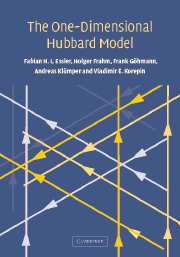Book contents
- Frontmatter
- Contents
- Preface
- 1 Introduction
- 2 The Hubbard Hamiltonian and its symmetries
- 3 The Bethe ansatz solution
- 4 String hypothesis
- 5 Thermodynamics in the Yang-Yang approach
- 6 Ground state properties in the thermodynamic limit
- 7 Excited states at zero temperature
- 8 Finite size corrections at zero temperature
- 9 Asymptotics of correlation functions
- 10 Scaling and continuum limits at half-filling
- 11 Universal correlations at low density
- 12 The algebraic approach to the Hubbard model
- 13 The path integral approach to thermodynamics
- 14 The Yangian symmetry of the Hubbard model
- 15 S-matrix and Yangian symmetry in the infinite interval limit
- 16 Hubbard model in the attractive case
- 17 Mathematical appendices
- References
- Index
12 - The algebraic approach to the Hubbard model
Published online by Cambridge University Press: 19 August 2009
- Frontmatter
- Contents
- Preface
- 1 Introduction
- 2 The Hubbard Hamiltonian and its symmetries
- 3 The Bethe ansatz solution
- 4 String hypothesis
- 5 Thermodynamics in the Yang-Yang approach
- 6 Ground state properties in the thermodynamic limit
- 7 Excited states at zero temperature
- 8 Finite size corrections at zero temperature
- 9 Asymptotics of correlation functions
- 10 Scaling and continuum limits at half-filling
- 11 Universal correlations at low density
- 12 The algebraic approach to the Hubbard model
- 13 The path integral approach to thermodynamics
- 14 The Yangian symmetry of the Hubbard model
- 15 S-matrix and Yangian symmetry in the infinite interval limit
- 16 Hubbard model in the attractive case
- 17 Mathematical appendices
- References
- Index
Summary
Introduction to the quantum inverse scattering method
The quantum inverse scattering method is the modern algebraic theory of exactly solvable quantum systems. It arose [404, 410, 411] as an attempt to carry over the concepts of the inverse scattering method for classical non-linear evolution equations [2, 134] into quantum mechanics. As a result, our understanding of both the theory of integrable partial differential equations and the theory of exactly solvable quantum systems changed, and the algebraic roots of the exact solvability became apparent. These roots originate from the Yang-Baxter equation and its classical counterpart.
Before turning to our actual subject, which is the application of the quantum inverse scattering method to the Hubbard model, we give a brief general introduction. We shall limit our exposition basically to the material which is needed later for the understanding of the algebraic structure of the Hubbard model. The reader who is interested in the general scope of the method and in the history of its development is referred to the excellent books and review articles [131, 270, 276, 277, 407].
Integrability
As a motivation for the definition of the Yang-Baxter algebra in the following subsection we shall first recall the concept of integrability in classical mechanics. Then, by considering the elementary example of the harmonic oscillator, we shall see that this concept does not directly apply to quantum mechanical systems and needs to be extended.
Information
- Type
- Chapter
- Information
- The One-Dimensional Hubbard Model , pp. 393 - 487Publisher: Cambridge University PressPrint publication year: 2005
